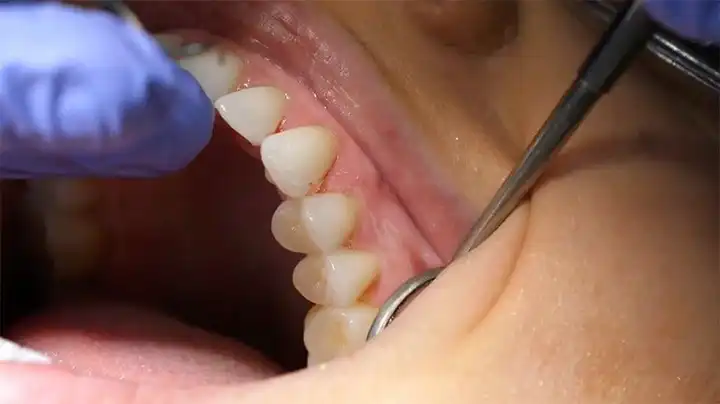8 Reasons Why You Have White Spots On Your Gums


Have you ever taken a nice, close look at your gum tissue in the mirror? We call these tissues “gingiva”. Normally, at least in most people, gum tissue has a coral-pink color to it. Some individuals with darker skin pigments can occasionally have gums that are dark brown or a combination of brown and pink.
But one thing that isn’t very normal is having white gums, getting white spots on gums, or seeing other visible changes in tissues that look different from the gingiva around it. Knowing what’s “normal” and what isn’t can help you know when it’s time to see your dentist for treatment.
Common Symptoms
Are white spots on gums painful? Not usually. In most cases people notice the white spots on gums when they’re looking at something else inside of their mouth. Having white gums or speckled areas of discoloration are usually differentiated from one another based on other symptoms, such as:
- bleeding
- pus or drainage
- a bad taste in your mouth
- whether the area wipes off
- how large the white area is
- where the white spots are located
- burning sensations
- tooth pain
- lesions visible on dental X-rays
8 Common Causes For White Spots On Your Gums
There are numerous factors that can contribute to white gums. Are white spots on gums painful? Not always. In fact, they rarely are. Being able to understand the underlying factors will help you minimize the risk of a dental emergency, life-threatening illness, or quickly treat the issue at hand.
If you tend to get red or white spots throughout your mouth, here are some of the most common causes and what you need to know about each one.
1) Canker Sores
Symptoms
Ulcers or “canker sores” are commonly linked to irritation, trauma (bumps to your mouth,) orthodontic appliances, acidic foods, or acid reflux disease. Minor canker sores tend to look like small, white, round circles inside of your lips, in the floor of the mouth, sides of the tongue, or directly on the gums. Most canker sores are extremely sensitive.
Treatment
2) Oral Thrush
Symptoms
Treatment
Good oral hygiene is key to treating oral thrush. Always clean your mouth immediately after meals. Consider adding yogurt to your diet, as it’s a natural probiotic. Severe cases of oral thrush may need to be treated with an antifungal medication. For babies, use a clean damp cloth to wipe their mouths out after each feeding.
3) Leukoplakia
Symptoms
Treatment
Most types of leukoplakia do not need to be “treated” per se. Generally, dentists will tell you to watch it and make sure it doesn’t get worse and allow the white or gray patches to go away on its own. If the area is due to some type of tissue trauma or habit, behavior modification is typically the best treatment.
4) Oral Lichen Planus
Symptoms
Treatment
Most oral lichen planus treatments are focused around minimizing the symptoms of pain or burning. In some cases, a biopsy or bloodwork may be needed for additional diagnostics. A topical corticosteroid may be prescribed.
5) Oral Cancer
Symptoms
Treatment
The best treatment for oral cancer is early diagnosis. If you have a sore that’s not healing, let your dentist know so that they can order a biopsy. Surgery or radiation therapy may be needed, depending on the extent of the disease. Unfortunately, most people do not self-diagnose oral cancer until it is quite aggressive. Seeing your dentist regularly (every six months) for an exam and oral cancer screening could save your life.
6) Cyst
Symptoms
There are numerous types of dental cysts that can develop inside of a person’s mouth. They are not all painful and do not always cause white gums. However, if you notice an unnaturally raised area where the tissues are stretched out, puffy, or appear to be depressible, it could be that there is some type of cyst developing just underneath your gums.
Treatment
Your dentist will probably refer you to an oral surgeon to have the cyst biopsied and/or removed. Since cysts can be caused by various factors, it’s important to rule out any pathology.
7) Periapical Abscess
Symptoms
Abscessed teeth tend to cause a singular white spot on gums, at the area where the infection is draining. You may notice a “fistula” (small pimple) where the salty discharge builds up. The tooth may or may not hurt.
Treatment
Root canal therapy or extraction is a typical treatment that can restore an abscessed or dying tooth. If swelling is present and the face looks asymmetrical, going to the ER immediately is recommended.
8) Periodontal Abscess
Symptoms
Chronic gum disease (periodontal disease or periodontitis) may lead to visible areas of swelling or abscesses along the gumlines if the infection is severe.
Treatment
Preventing White Spots On Gums
Ultimately the best way to prevent common white spots on gums or other areas of your mouth is to practice great oral hygiene. Since white spots on gums are frequently linked to dental infections, taking good care of your mouth can lower your chances of such complications.
White gums can also be a sign of medical issues — like anemia or iron deficiency — so if it’s more generalized, you might want to have some bloodwork done.
Unfortunately, white spots on gums aren’t always preventable. If you have something like oral cancer (and you’ve already taken preventive steps like minimizing sun exposure or avoiding tobacco) the best treatment is early diagnosis.
People with weak immune systems or who are immunocompromised will be more prone to things like oral thrush or lichen planus. Again, oral hygiene comes into play to keep a clean environment that’s less likely to lead to white gums.
If you have orthodontic appliances or a removable prosthetic (such as a full denture or partial,) keeping your mouth clean is crucial. Poor oral hygiene can quickly lead to infections, swollen gums, raw tissues, thrush, etc.
If there’s only one takeaway that you remember when it comes to white gums, it’s to keep your mouth clean!
Pain Relief At Home
Are white spots on gums painful? Usually not unless they’re associated with a canker sore or periodontal abscess. If you’re already in communication with your dentist about getting the proper treatment, here are a few easy things you can do to minimize discomfort while you’re still at home:
- Rinse with warm salt water a few times a day, to draw out any swelling or inflammation.
- Take an over-the-counter anti-inflammatory medication such as ibuprofen or Motrin as directed.
- Eat cool, soft foods to minimize irritation.
- Clean your mouth immediately after eating or drinking anything other than water.
- Use over-the-counter gels or sprays as directed, but no longer than a couple of days.
If the discomfort is severe, ask your dentist about getting a prescription for what’s called “miracle mouthwash.” This special rinse contains lidocaine, which can numb any sores inside of your mouth for a few hours at a time, making it easier for you to get through the day.
Overcoming White Spots On Gums
White spots on gums, painful or not, aren’t what you consider “healthy” or “normal.” Depending on their cause and severity, it could be something as minor as an everyday ulcer or severe as oral cancer. Keeping an eye on the area and letting your dentist know if it doesn’t heal within a week or so is the most important thing to keep in mind. Oral hygiene habits have a significant role to play when it comes to preventing white spots on gums. For more information, it’s best to see your dentist in person!

Make your inbox smile!
Subscribe






